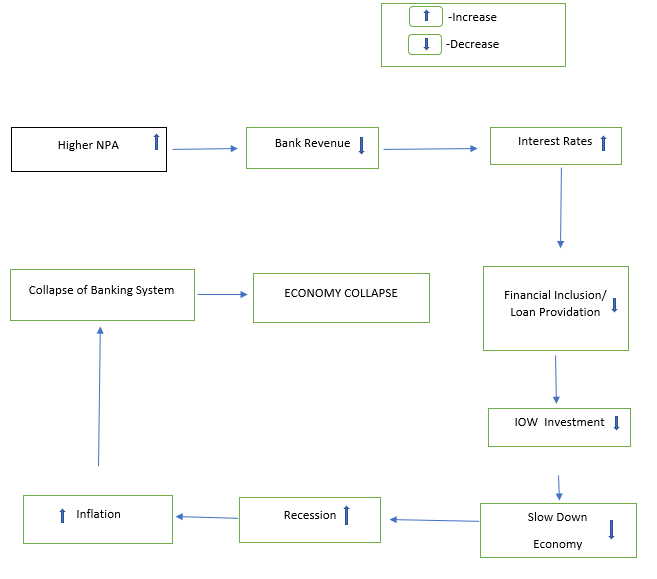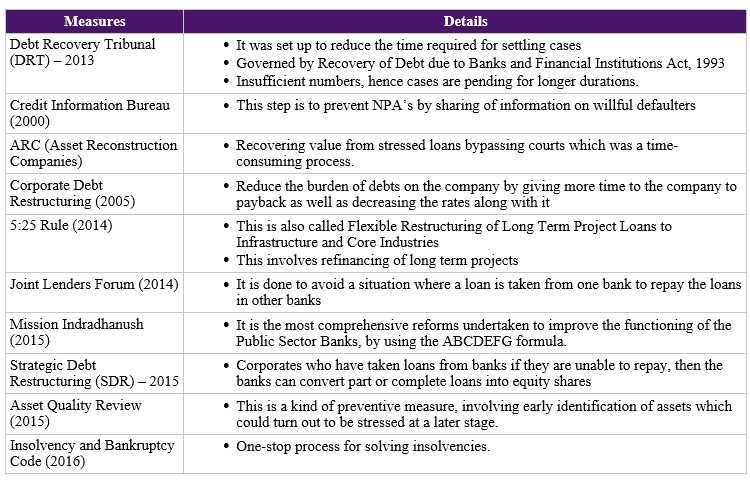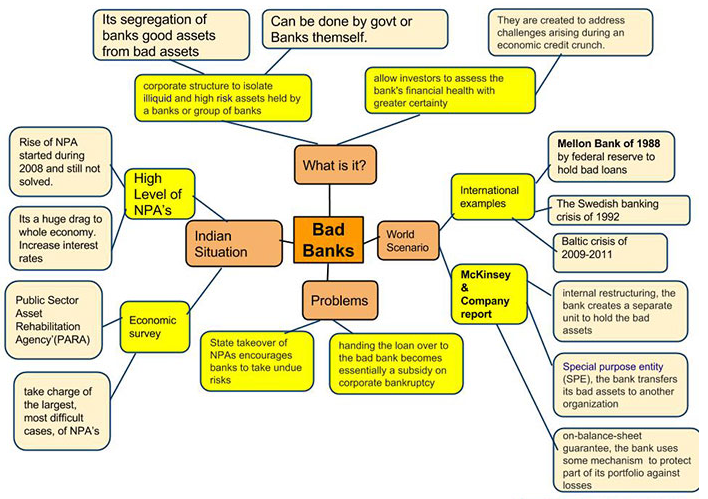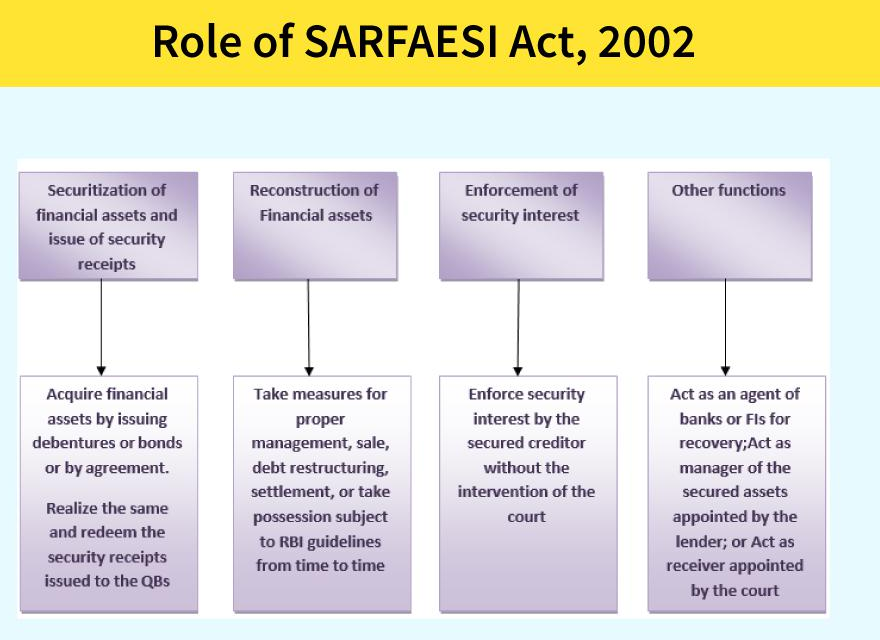The 20th Jan Static Quiz on Economy 2021 (Non-Performing Assests)
Quiz-summary
0 of 10 questions completed
Questions:
- 1
- 2
- 3
- 4
- 5
- 6
- 7
- 8
- 9
- 10
Information
The 20th Jan Static Quiz on Economy 2021 (Non-Performing Assets)
You have already completed the quiz before. Hence you can not start it again.
Quiz is loading...
You must sign in or sign up to start the quiz.
You have to finish following quiz, to start this quiz:
Results
0 of 10 questions answered correctly
Your time:
Time has elapsed
You have reached 0 of 0 points, (0)
Categories
- Not categorized 0%
- 1
- 2
- 3
- 4
- 5
- 6
- 7
- 8
- 9
- 10
- Answered
- Review
- Question 1 of 10
1. Question
Which of the following statements about Non-Performing Assests (NPA) are incorrect?
1. A non-performing loan is a loan that is in default or close to being in default.
2. Many loans become non-performing after being in default for 180 days, but this can depend on the contract terms.CorrectAns;- b) Only 2
Explanation;-
• As question asked to choose incorrect the 2nd statement is incorrect because it is after 90 days it will be NPA not 180 days.
About NPA
• A non-performing loan is a loan that is in default or close to being in default. Many loans become non-performing after being in default for 90 days, but this can depend on the contract terms.
• According to International Monetary Fund npl is as follows;-1. Payments of interest and principal are past due by 90 days or more.
2. At least 90 days of interest payments have been capitalized, refinanced or delayed by agreement.
3. Payments are less than 90 days overdue, but there are other good reasons to doubt that payments will be made in full”.• By bank regulatory definition, non-performing loans consist of:-
1. other real estate owned which is taken by foreclosure or a deed in lieu of foreclosure,
2. loans that are 90 days or more past due and still accruing interest, and
3. loans which have been placed on nonaccrual (i.e., loans for which interest is no longer accrued and posted to the income statement).• In India, non-performing loans are common in the agricultural sector where the farmers can’t pay back the loan or the interest amount mainly as a result of losses due to floods or drought.
• Generally NPL problems are resolved in two ways:-
1. Centralization – This happens when all the concerned parties including the banks, regulators and government get together to find solutions.
This generally takes the form of a central organization/agency such as an Asset Management Company.
2. Decentralization – This approach involves steps taken by the affected banks. The decentralized approach is common for bad loans arising from bad lending. In this approach, the banks are left alone to manage their own bad loans by giving them incentives, legislative powers, or special accounting or fiscal advantages.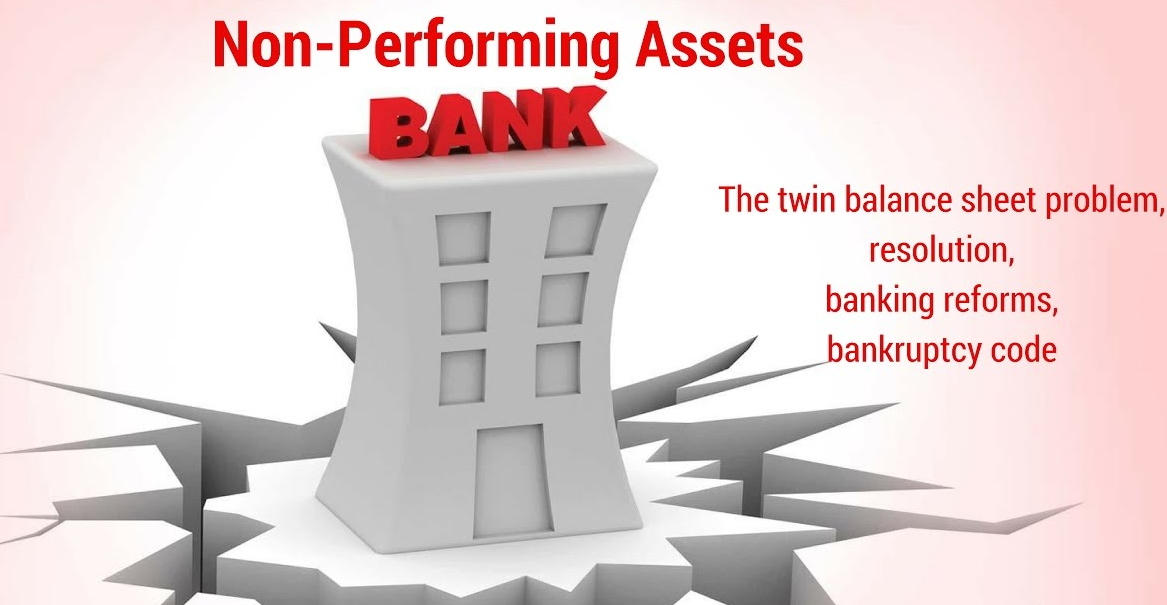 Incorrect
IncorrectAns;- b) Only 2
Explanation;-
• As question asked to choose incorrect the 2nd statement is incorrect because it is after 90 days it will be NPA not 180 days.
About NPA
• A non-performing loan is a loan that is in default or close to being in default. Many loans become non-performing after being in default for 90 days, but this can depend on the contract terms.
• According to International Monetary Fund npl is as follows;-1. Payments of interest and principal are past due by 90 days or more.
2. At least 90 days of interest payments have been capitalized, refinanced or delayed by agreement.
3. Payments are less than 90 days overdue, but there are other good reasons to doubt that payments will be made in full”.• By bank regulatory definition, non-performing loans consist of:-
1. other real estate owned which is taken by foreclosure or a deed in lieu of foreclosure,
2. loans that are 90 days or more past due and still accruing interest, and
3. loans which have been placed on nonaccrual (i.e., loans for which interest is no longer accrued and posted to the income statement).• In India, non-performing loans are common in the agricultural sector where the farmers can’t pay back the loan or the interest amount mainly as a result of losses due to floods or drought.
• Generally NPL problems are resolved in two ways:-
1. Centralization – This happens when all the concerned parties including the banks, regulators and government get together to find solutions.
This generally takes the form of a central organization/agency such as an Asset Management Company.
2. Decentralization – This approach involves steps taken by the affected banks. The decentralized approach is common for bad loans arising from bad lending. In this approach, the banks are left alone to manage their own bad loans by giving them incentives, legislative powers, or special accounting or fiscal advantages.
- Question 2 of 10
2. Question
Which of the following about types of Non-Performing Assets are incorrect?
1. Substandard Assets = If the asset is in the substandard category for a period of 12 months
2. Doubtful Assets = These assets are of little value, it can no longer continue as a bankable asset, there could be some recovery value.
3. Loss Assets = These are the assets which have remained NPA for a period of less than or equal to 12 monthsCorrectAns;- d) All of the above
Explanation;-
• As question asked to choose incorrect statement all are incorrectly matched.
• Based on different parameters the Non Performing Assets are classified into different types.
• The below table gives the different classification of Non Performing Assets:- Incorrect
IncorrectAns;- d) All of the above
Explanation;-
• As question asked to choose incorrect statement all are incorrectly matched.
• Based on different parameters the Non Performing Assets are classified into different types.
• The below table gives the different classification of Non Performing Assets:-
- Question 3 of 10
3. Question
Which of the following are the impacts are the Non-Performing Assets ?
1. Banks won’t have sufficient funds for other development projects which will impact the economy
2. To maintain a profit margin, banks will be forced to decrease interest rates.
3. Due to the curb in further investments, it may lead to the rise of unemployment.CorrectAns;- c) Only 1 and 3
Explanation;-
• The 2nd statement is incorrect because it is forced to increase interest rates.
Impacts of Non-Performing Assets (NPA)
• Think of nonperforming assets as dead weight on the balance sheet.
1. Banks won’t have sufficient funds for other development projects which will impact the economy
2. To maintain a profit margin, banks will be forced to increase interest rates.
3. Due to the curb in further investments, it may lead to the rise of unemployment. Incorrect
IncorrectAns;- c) Only 1 and 3
Explanation;-
• The 2nd statement is incorrect because it is forced to increase interest rates.
Impacts of Non-Performing Assets (NPA)
• Think of nonperforming assets as dead weight on the balance sheet.
1. Banks won’t have sufficient funds for other development projects which will impact the economy
2. To maintain a profit margin, banks will be forced to increase interest rates.
3. Due to the curb in further investments, it may lead to the rise of unemployment.
- Question 4 of 10
4. Question
Which of the following are the initiatives taken by Government of India and RBI to control Non-Performing Assests?
1. Debt Recovery Tribunal (DRT)
2. Asset Reconstruction Companies
3. Credit Information BureauCorrectExplanation;-
• All the above initiatives are taken to control NPA
About Measures to control Non-Performing Assets (NPA) – Government of India and RBI
• As the Non-Performing Assets is not a new phenomenon, there have been many efforts on the part of the Government of India and RBI to sort out the problem.
• Below table gives the list of measures taken to control Non-Performing Assets (NPA) Incorrect
IncorrectExplanation;-
• All the above initiatives are taken to control NPA
About Measures to control Non-Performing Assets (NPA) – Government of India and RBI
• As the Non-Performing Assets is not a new phenomenon, there have been many efforts on the part of the Government of India and RBI to sort out the problem.
• Below table gives the list of measures taken to control Non-Performing Assets (NPA)
- Question 5 of 10
5. Question
Which of the following about Insolvency and Bankruptcy Code, 2016?
1. Bankruptcy is a situation where individuals or companies are unable to repay their outstanding debt.
2. The Insolvency and Bankruptcy Code, 2016 is the bankruptcy law of India which seeks to consolidate the existing framework by creating a single law for insolvency and bankruptcy.
3. The Insolvency and Bankruptcy Code, 2015 was introduced in Lok Sabha in December 2015.CorrectAns;- b) Only 2 and 3
Explanation;-
• The 1st statement is incorrect because Insolvency is a situation where individuals or companies are unable to repay their outstanding debt.
About Insolvency and Bankruptcy Code, 2016
• Insolvency and Bankruptcy Code, 2016 provides a time-bound process for resolving insolvency in companies and among individuals.
• Insolvency is a situation where individuals or companies are unable to repay their outstanding debt.
• Bankruptcy, on the other hand, is a situation whereby a court of competent jurisdiction has declared a person or other entity insolvent, having passed appropriate orders to resolve it and protect the rights of the creditors. It is a legal declaration of one’s inability to pay off debts.
• The Government implemented the Insolvency and Bankruptcy Code (IBC) to consolidate all laws related to insolvency and bankruptcy and to tackle Non-Performing Assets (NPA), a problem that has been pulling the Indian economy down for years.
• The Code is quite different from the earlier resolution systems as it shifts the responsibility to the creditor to initiate the insolvency resolution process against the corporate debtor.
• The recently proposed amendments aim to remove bottlenecks, streamline the corporate insolvency resolution process, and protect the last mile funding in order to boost investment in financially distressed sectors.
• Ring-fencing the companies resolved under the IBC from regulatory actions during past management can make the IBC process attractive for investors and acquirers.About Objectives of IBC
• To consolidate and amend all existing insolvency laws in India.
• To simplify and expedite the Insolvency and Bankruptcy Proceedings in India.
• To protect the interest of creditors including stakeholders in a company.
• To revive the company in a time-bound manner.
• To promote entrepreneurship.
• To get the necessary relief to the creditors and consequently increase the credit supply in the economy.
• To work out a new and timely recovery procedure to be adopted by the banks, financial institutions or individuals.
• To set up an Insolvency and Bankruptcy Board of India.
• Maximization of the value of assets of corporate persons.Salient features of the Insolvency and Bankruptcy Code, 2016
• Covers all individuals, companies, Limited Liability Partnerships (LLPs) and partnership firms.
• Adjudicating authority:
• National Company Law Tribunal (NCLT) for companies and LLPs
• Debt Recovery Tribunal (DRT) for individuals and partnership firmsIncorrectAns;- b) Only 2 and 3
Explanation;-
• The 1st statement is incorrect because Insolvency is a situation where individuals or companies are unable to repay their outstanding debt.
About Insolvency and Bankruptcy Code, 2016
• Insolvency and Bankruptcy Code, 2016 provides a time-bound process for resolving insolvency in companies and among individuals.
• Insolvency is a situation where individuals or companies are unable to repay their outstanding debt.
• Bankruptcy, on the other hand, is a situation whereby a court of competent jurisdiction has declared a person or other entity insolvent, having passed appropriate orders to resolve it and protect the rights of the creditors. It is a legal declaration of one’s inability to pay off debts.
• The Government implemented the Insolvency and Bankruptcy Code (IBC) to consolidate all laws related to insolvency and bankruptcy and to tackle Non-Performing Assets (NPA), a problem that has been pulling the Indian economy down for years.
• The Code is quite different from the earlier resolution systems as it shifts the responsibility to the creditor to initiate the insolvency resolution process against the corporate debtor.
• The recently proposed amendments aim to remove bottlenecks, streamline the corporate insolvency resolution process, and protect the last mile funding in order to boost investment in financially distressed sectors.
• Ring-fencing the companies resolved under the IBC from regulatory actions during past management can make the IBC process attractive for investors and acquirers.About Objectives of IBC
• To consolidate and amend all existing insolvency laws in India.
• To simplify and expedite the Insolvency and Bankruptcy Proceedings in India.
• To protect the interest of creditors including stakeholders in a company.
• To revive the company in a time-bound manner.
• To promote entrepreneurship.
• To get the necessary relief to the creditors and consequently increase the credit supply in the economy.
• To work out a new and timely recovery procedure to be adopted by the banks, financial institutions or individuals.
• To set up an Insolvency and Bankruptcy Board of India.
• Maximization of the value of assets of corporate persons.Salient features of the Insolvency and Bankruptcy Code, 2016
• Covers all individuals, companies, Limited Liability Partnerships (LLPs) and partnership firms.
• Adjudicating authority:
• National Company Law Tribunal (NCLT) for companies and LLPs
• Debt Recovery Tribunal (DRT) for individuals and partnership firms - Question 6 of 10
6. Question
Which of the following are the reasons for the rise of NPA in India?
1. Historical factors
2. Relaxed lending norms
3. Lack of contingency planning
4. Restructuring of loan facilityCorrectAns;- d) All of the above
Explanation;-
• All are the reasons are the rise of NPA in India.
 Incorrect
IncorrectAns;- d) All of the above
Explanation;-
• All are the reasons are the rise of NPA in India.

- Question 7 of 10
7. Question
Which of the following statements about Mission Indradhanush 2015 are correct?
1. The government of India, to resolve the issues faced by the Public Sector Banks, launched a 7 pronged plan called “Mission Indradhanush” in 2015.
2. The Indradhanush for PSBs mission aims at revamping the functioning of the Public Sector Banks to enable them to compete with the Private Sector Banks.
3. The Indradhanush for PSBs mission aims at revamping the functioning of the Public Sector Banks to enable them to compete with the Private Sector Banks.CorrectAns;- d) All of the above
Explanation;-
• All the statemensts are correct about Mission Indradhanush 2015.
About Mission Indradhanush 2015
• The government of India, to resolve the issues faced by the Public Sector Banks, launched a 7 pronged plan called “Mission Indradhanush” in 2015. The Indradhanush for PSBs mission aims at revamping the functioning of the Public Sector Banks to enable them to compete with the Private Sector Banks. It seeks to revive economic growth through the reduction of political interference in the functioning of PSBs and improving credit.
• Components of Mission Indradhanush for PSBs
• Many of the measures are suggested by the PJ Nayak Committee on the banking reforms. The 7 components of the Mission (symbolic of 7 colors of the rainbow) plan to address the challenges faced by the Public Sector Banks.
• The 7 components include:
• Appointments: Besides induction of talent from the Private Sector into the public banks, separation of the posts of Chief Executive Officer and the Managing Director, in order to check the excessive concentration of power and smooth functioning of the banks.
• Bank Boards Bureau: The appointments Board of the Public Sector Banks would be replaced by the Bank Boards Bureau (BBB)
• Advice would be rendered to the banks in the matters of raising funds, mergers and acquisitions etc by the BBB. It would also hold the bad assets of the Public Sector Banks. The BBB separates the functioning of the PSBs from the government by acting as a middleman.
• Capitalization: Due to the high NPA’s and the need to meet the provisions of the Basel III norms, capitalization of banks by inducing Rs. 70000 crore was planned.
• De-stressing: Solving issues arising in the infrastructure sector in order to check the stressed assets in the banks by strengthening the asset reconstruction companies. Development of a vibrant debt market for PSBs.
• Empowerment: Providing greater flexibility and autonomy to PSBs in hiring manpower.
• Framework of Accountability: The assessment of the banks would be based on a few key performance indicators. It would be inclusive of
1. Quantitative Parameters such as Non-Performing Assets Management, growth, diversification, return on capital, financial inclusion and
2. Qualitative Parameters such as steps taken in improving asset quality, human resources initiatives etc.
3. Governance Reforms: Banker’s Retreat or the Gyan Sangam conferences between the bankers and the government officials for resolving the banking sector issues and deciding the future course of action.IncorrectAns;- d) All of the above
Explanation;-
• All the statemensts are correct about Mission Indradhanush 2015.
About Mission Indradhanush 2015
• The government of India, to resolve the issues faced by the Public Sector Banks, launched a 7 pronged plan called “Mission Indradhanush” in 2015. The Indradhanush for PSBs mission aims at revamping the functioning of the Public Sector Banks to enable them to compete with the Private Sector Banks. It seeks to revive economic growth through the reduction of political interference in the functioning of PSBs and improving credit.
• Components of Mission Indradhanush for PSBs
• Many of the measures are suggested by the PJ Nayak Committee on the banking reforms. The 7 components of the Mission (symbolic of 7 colors of the rainbow) plan to address the challenges faced by the Public Sector Banks.
• The 7 components include:
• Appointments: Besides induction of talent from the Private Sector into the public banks, separation of the posts of Chief Executive Officer and the Managing Director, in order to check the excessive concentration of power and smooth functioning of the banks.
• Bank Boards Bureau: The appointments Board of the Public Sector Banks would be replaced by the Bank Boards Bureau (BBB)
• Advice would be rendered to the banks in the matters of raising funds, mergers and acquisitions etc by the BBB. It would also hold the bad assets of the Public Sector Banks. The BBB separates the functioning of the PSBs from the government by acting as a middleman.
• Capitalization: Due to the high NPA’s and the need to meet the provisions of the Basel III norms, capitalization of banks by inducing Rs. 70000 crore was planned.
• De-stressing: Solving issues arising in the infrastructure sector in order to check the stressed assets in the banks by strengthening the asset reconstruction companies. Development of a vibrant debt market for PSBs.
• Empowerment: Providing greater flexibility and autonomy to PSBs in hiring manpower.
• Framework of Accountability: The assessment of the banks would be based on a few key performance indicators. It would be inclusive of
1. Quantitative Parameters such as Non-Performing Assets Management, growth, diversification, return on capital, financial inclusion and
2. Qualitative Parameters such as steps taken in improving asset quality, human resources initiatives etc.
3. Governance Reforms: Banker’s Retreat or the Gyan Sangam conferences between the bankers and the government officials for resolving the banking sector issues and deciding the future course of action. - Question 8 of 10
8. Question
Which of the following about Bad Banks are correct ?
1. A bad bank is a bank set up to buy the bad loans and other illiquid holdings of another financial institution.
2. A bad bank structure may also assume the risky assets of a group of financial institutions, instead of a single bank.
3. In the Economic Survey Report 2017, Chief Economic Adviser Arvind Subramanian had suggested the creation of Public Sector Asset Rehabilitation Agency (PARA) which will work as a “Bad bank” to absorb the losses from the PSBs.CorrectAns;- d) All of the above
Explanation;-
• All the statements are correct about Bad Bank
About Bad Bank
• A bad bank is a bank set up to buy the bad loans and other illiquid holdings of another financial institution.
• The entity holding significant nonperforming assets will sell these holdings to the bad bank at market price. By transferring such assets to the bad bank, the original institution may clear its balance sheet—although it will still be forced to take write-downs.
• A bad bank structure may also assume the risky assets of a group of financial institutions, instead of a single bank.
• Bad banks are typically set up in times of crisis when long-standing financial institutions are trying to recuperate their reputations and wallets. While shareholders and bondholders generally stand to lose money from this solution, depositors usually do not.
• Banks that become insolvent as a result of the process can be recapitalized, nationalized, or liquidated. If they do not become insolvent, it is possible for a bad bank’s managers to focus exclusively on maximizing the value of its newly acquired high-risk assets.
• Some criticize the setup of bad banks, highlighting how if states take over non-performing loans, this encourages banks to take undue risks, leading to a moral hazard.
• The 2017 Economic Survey examined this idea, suggesting the creation of a Public Sector Asset Rehabilitation Agency (PARA).
• Before that, the 2015 Asset Quality Review conducted by Reserve Bank under Governor Raghuram Rajan, which forced banks to recognize problem accounts as non-performing assets, had also sparked a debate on bad bank as a possible solution.
• In short, the idea is not novel and has been suggested by various people at different points of time. Incorrect
IncorrectAns;- d) All of the above
Explanation;-
• All the statements are correct about Bad Bank
About Bad Bank
• A bad bank is a bank set up to buy the bad loans and other illiquid holdings of another financial institution.
• The entity holding significant nonperforming assets will sell these holdings to the bad bank at market price. By transferring such assets to the bad bank, the original institution may clear its balance sheet—although it will still be forced to take write-downs.
• A bad bank structure may also assume the risky assets of a group of financial institutions, instead of a single bank.
• Bad banks are typically set up in times of crisis when long-standing financial institutions are trying to recuperate their reputations and wallets. While shareholders and bondholders generally stand to lose money from this solution, depositors usually do not.
• Banks that become insolvent as a result of the process can be recapitalized, nationalized, or liquidated. If they do not become insolvent, it is possible for a bad bank’s managers to focus exclusively on maximizing the value of its newly acquired high-risk assets.
• Some criticize the setup of bad banks, highlighting how if states take over non-performing loans, this encourages banks to take undue risks, leading to a moral hazard.
• The 2017 Economic Survey examined this idea, suggesting the creation of a Public Sector Asset Rehabilitation Agency (PARA).
• Before that, the 2015 Asset Quality Review conducted by Reserve Bank under Governor Raghuram Rajan, which forced banks to recognize problem accounts as non-performing assets, had also sparked a debate on bad bank as a possible solution.
• In short, the idea is not novel and has been suggested by various people at different points of time.
- Question 9 of 10
9. Question
Which of the following about SARFAESI Act are correct?
1. The Securitization and Reconstruction of Financial Assets and Enforcement of Securities Interest Act, 2002 is an Indian law.
2. It allows banks and other financial institution to auction residential or commercial properties to recover loans.
3. The first asset reconstruction company (ARC) of India, ARCIL, was set up under this act.CorrectAns;- d) All of the above
Explanation;-
• All of the statements are correct.
About SARFESI Act
• The Securitization and Reconstruction of Financial Assets and Enforcement of Securities Interest Act, 2002 (also known as the SARFAESI Act) is an Indian law.
• It allows banks and other financial institution to auction residential or commercial properties (of Defaulter) to recover loans.
• The first asset reconstruction company (ARC) of India, ARCIL, was set up under this act.[2] Under this act secured creditors (banks or financial institutions) have many right for enforcement of security interest under section 13 of SARFAESI Act, 2002.
• If borrower of financial assistance makes any default in repayment of loan or any installment and his account is classified as Non performing Asset by secured creditor, then secured creditor may require before expiry of period of limitation by written notice.
• The law does not apply to unsecured loans, loans below ₹200,000 or where remaining debt is below 20% of the original principal.
• This law allowed the creation of asset reconstruction companies (ARC) and allowed banks to sell their non-performing assets to ARC’s. Banks are allowed to take possession of the collateral property and sell it without the permission of a court.
• The act was amended by “Enforcement of Security Interest and Recovery of Debts Laws and Miscellaneous Provisions (Amendment) Bill, 2016”, passed by Lok Sabha on 2 August 2016.
• Act passed by Rajya Sabha by voice vote on 10 August 2016. Incorrect
IncorrectAns;- d) All of the above
Explanation;-
• All of the statements are correct.
About SARFESI Act
• The Securitization and Reconstruction of Financial Assets and Enforcement of Securities Interest Act, 2002 (also known as the SARFAESI Act) is an Indian law.
• It allows banks and other financial institution to auction residential or commercial properties (of Defaulter) to recover loans.
• The first asset reconstruction company (ARC) of India, ARCIL, was set up under this act.[2] Under this act secured creditors (banks or financial institutions) have many right for enforcement of security interest under section 13 of SARFAESI Act, 2002.
• If borrower of financial assistance makes any default in repayment of loan or any installment and his account is classified as Non performing Asset by secured creditor, then secured creditor may require before expiry of period of limitation by written notice.
• The law does not apply to unsecured loans, loans below ₹200,000 or where remaining debt is below 20% of the original principal.
• This law allowed the creation of asset reconstruction companies (ARC) and allowed banks to sell their non-performing assets to ARC’s. Banks are allowed to take possession of the collateral property and sell it without the permission of a court.
• The act was amended by “Enforcement of Security Interest and Recovery of Debts Laws and Miscellaneous Provisions (Amendment) Bill, 2016”, passed by Lok Sabha on 2 August 2016.
• Act passed by Rajya Sabha by voice vote on 10 August 2016.
- Question 10 of 10
10. Question
What is termed as Loss Asset?
CorrectAns;- a) Sub standard assets for more than 3 years
Explanation;-
• A lost asset is the one which remains as NPA for a period of more than 36 months. Such an asset has been identified by the bank or internal or external auditors or by the RBI inspection but the amount has not been written off wholly. In other words, such an asset is considered uncollectible.
IncorrectAns;- a) Sub standard assets for more than 3 years
Explanation;-
• A lost asset is the one which remains as NPA for a period of more than 36 months. Such an asset has been identified by the bank or internal or external auditors or by the RBI inspection but the amount has not been written off wholly. In other words, such an asset is considered uncollectible.


